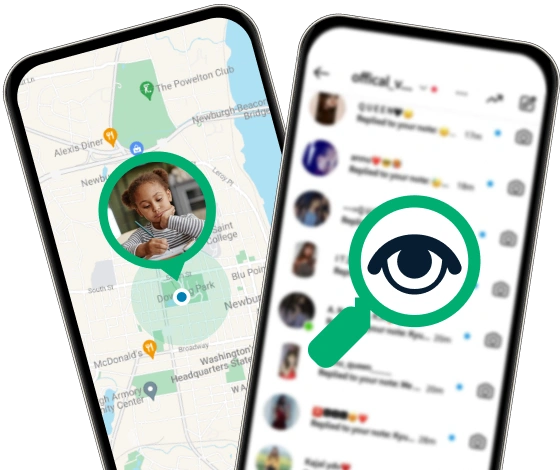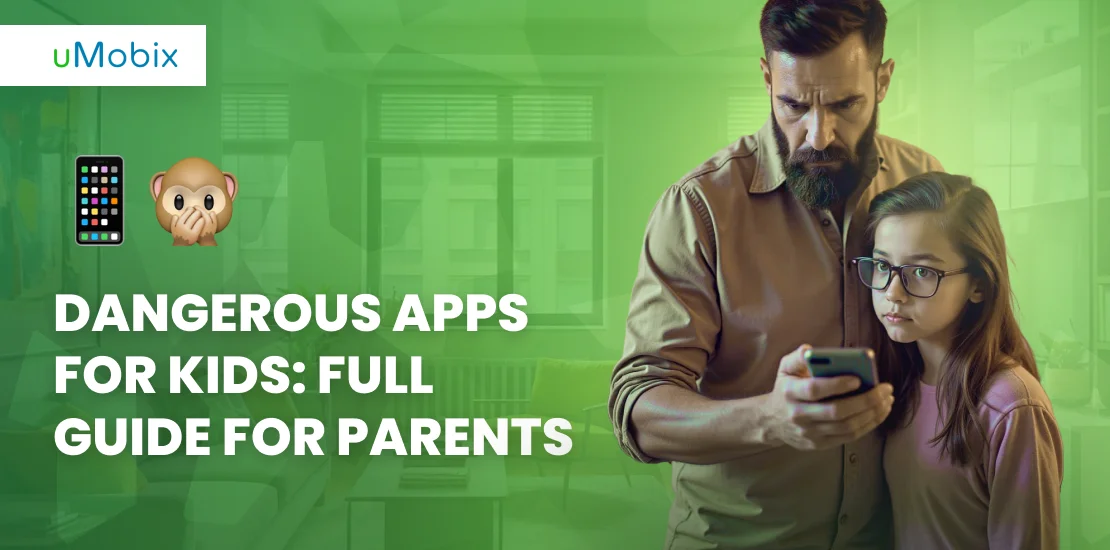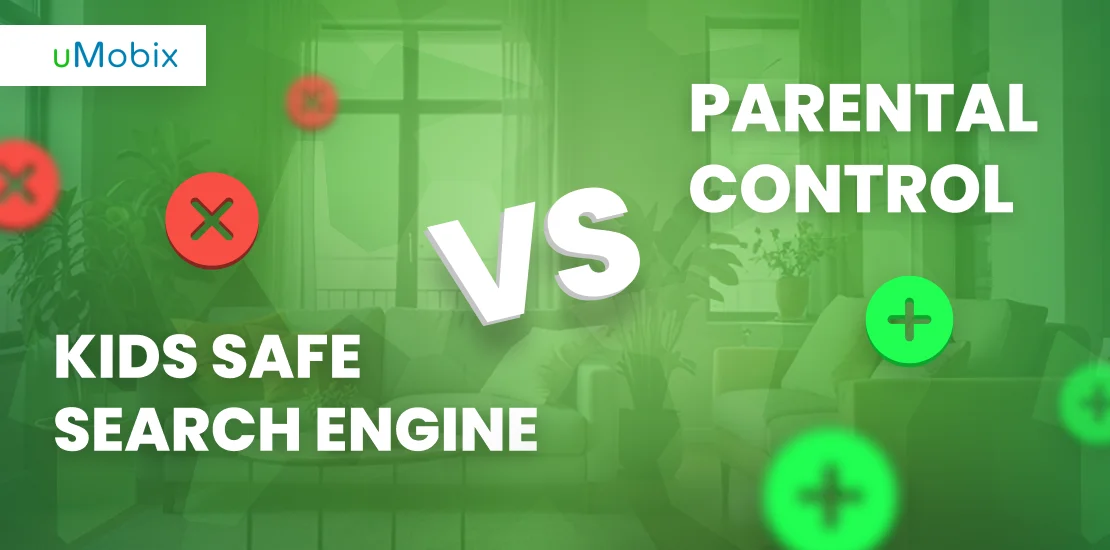Using apps is what our life is, and it would be weird if we didn’t do it, right? Right. The same can’t be said for our kids, though – stranger danger is still, regrettably, a thing, and no one can be 100% sure that a minor would be safe online. Stats say that many teens between 13 and 17 are all about TikTok (63%), Snapchat (60%), and Instagram (59%), and for older teens, like those 15 to 17, it’s even higher – around 7 in 10 use these apps regularly. And what about dating apps? 35% of girls aged 15 to 17 say they have received unwanted explicit images, as Pew Research Center reports.
This is why any parent should keep an eye out for dangerous apps for kids. Our article will guide you through risks usually associated with the most popular apps, as well as ways in which you can protect your kid. Read on!
Why Is It Important to Be Aware of the Worst Apps for Kids?
Knowing about the worst apps for kids is key because some of them might look innocent but can actually be really harmful. A lot of these apps come with hidden dangers, like unfiltered chat features where strangers can reach out or content that’s totally inappropriate for kids.
Then there’s the whole privacy issue – some worst apps for kids don’t protect personal info well, meaning your child’s data could be collected or shared without you even knowing. And don’t forget those sneaky in-app purchases! Kids can end up spending a ton without realizing it.
Most Dangerous Apps for Kids
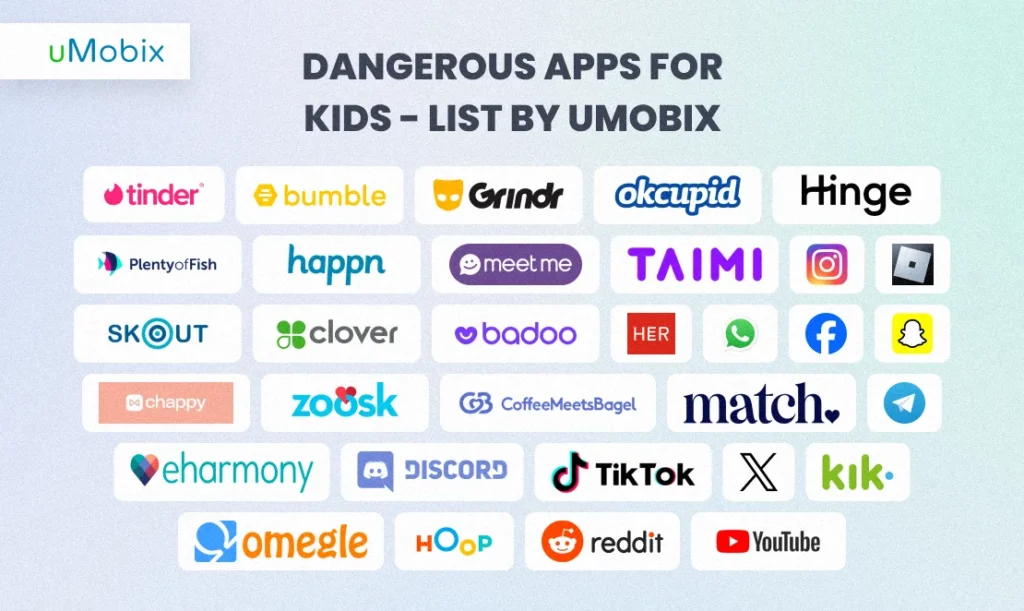
Gaslighting yourself into thinking that there aren’t that many apps that can be dangerous to your kid would be the easiest way out. After all, they can always turn to you if there’s any danger, and you can surely handle it all!
But you’re reading this article, and this means – you do want to get rid of the problem before it even touches your child. So, we are going to highlight the most dangerous apps for kids you should keep an eye out for.
Social Media Apps
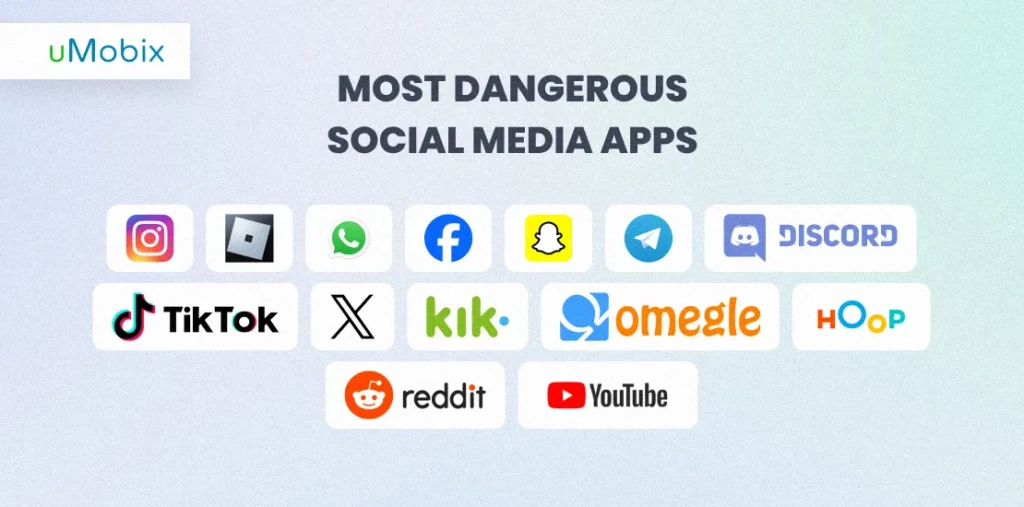
As should be obvious at this point, social media represent a massive share of dangerous apps for kids – especially when the dangers aren’t always obvious. Many platforms let users stay anonymous, making it easier for predators or scammers to target kids without getting caught, and we’re talking about Instagram scams or WhatsApp scams – which, honestly, doesn’t make it easier to understand what is the most dangerous social media app among all of them. And let’s not forget that kids can stumble upon disturbing parts – like sexual content, violent videos, or harmful trends – even on seemingly harmless apps, which is as bad as exposure to creeps.
Scams and identity theft are also on the rise. Kids might overshare personal info without realizing the risks, putting them in danger. Plus, cyberbullying is a huge issue, with kids facing harassment from peers or strangers, which can seriously impact their mental health and well-being.
That being said, these are the dangerous apps for kids that have the biggest potential of being unsettling to your child:
| Snapchat | Discord | |
| TikTok | Twitter/X | Yik Yak |
| Kik | Omegle | Roblox |
| Hoop | ||
| YouTube | Telegram |
Dating Apps
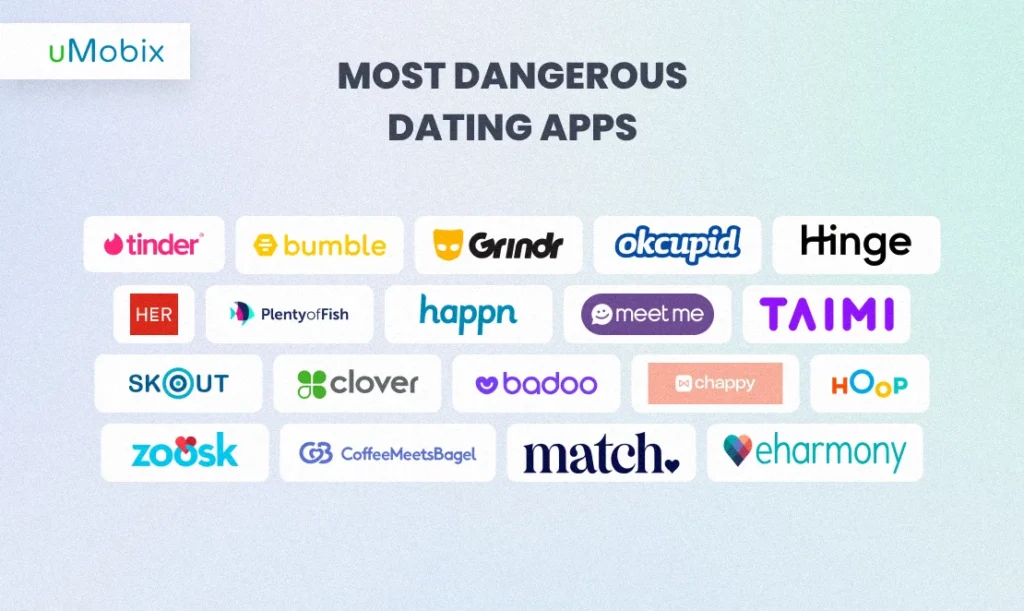
Dating apps are another thing. While the general consensus is that they are meant for adults (and should, in theory, filter out the minors), it’s shockingly easy for kids to sneak onto them. One major issue is exposure to adult content – like chats about drugs, alcohol, or sex. Some users send explicit messages or pics, leaving teens feeling uncomfortable or in dangerous situations. Even apps meant for “friendship” can be misused.
Plus, sharing location can lead to real-life dangers: nobody wants to be tracked down by someone they don’t know, and GPS-based apps make it too easy for strangers to meet up. Worse, these can make LGBTQ+ youth feel targeted when, in reality, they just want to explore their identity. That’s why the following can be considered dangerous apps for kids and should be closely monitored:
| Tinder | Bumble | Grindr |
| OkCupid | Hinge | Plenty of Fish (POF) |
| Happn | MeetMe | Taimi |
| Skout | Clover | Badoo |
| HER | Chappy | Zoosk |
| Coffee Meets Bagel | Match.com | eHarmony |
Omegle
You probably noticed how this app blew up during the COVID-19 lockdowns. Everyone was stuck at home, itching for some social interaction, so Omegle became a go-to for a lot of people looking to connect from a distance. Plus, TikTok influencers started sharing their hilarious and wild chats, which got even more young adults, or worse – minors curious about what all the fuss was about.
So, is Omegle safe? Well, while it can be a blast to meet new people, Omegle isn’t exactly the safest place out there – teens might come across explicit content, online predators, or even some cyberbullying. And because there’s no registration, it’s tough to hold people accountable for their actions, which makes it a bit of a Wild West for younger users.
Roblox
Is Roblox safe for kids – well, there’s the question. It’s a massive creative playground where they can make their own games and explore a million others. But with so many user-made games out there, it’s all too easy to run into games with sexual themes, cursing, or even references to drugs and violence, which can be detrimental to users under 13.
And don’t get us started on the chat feature! Sure, it’s great for kids to connect with their friends, but it can also lead to some pretty risky interactions with adult users who might not have the best intentions. Before they know it, kids could find themselves in conversations that get uncomfortable or even dangerous. Plus, Roblox is super immersive, which makes it way too easy for minors to share personal info without really thinking it through – and this makes it one of the most dangerous apps for kids.
Discord
Discord’s totally blown up with minors these days, being their go-to spot for hanging out and chatting about everything from gaming to school. But it wouldn’t be on the list of the most dangerous social media apps if it didn’t have any dangers.
First off, the way Discord is set up is kinda sketchy. Users can jump into all sorts of servers and channels, from huge public groups to private chats with just friends. So here you’ve got bullying, harassment, and even some creepy behavior from adults.
Plus, Discord doesn’t really have strong moderation, so hate speech or explicit content can pop up outta nowhere, and without parental oversight, kids can easily get caught up in negative influences and conversations that can seriously mess with their mental health. Honestly, reports often put Discord high on the list for bullying and other mental health issues.
Among Us
Among Us is a super fun game, but probably not for minors – what starts off as just some silly fun can turn into confusion around honesty, and honestly, they might not get the full picture yet. But is Among Us safe for kids yet? There’s a lot to unpack here.
First, there’s the chat feature. Even though there’s a language filter, it doesn’t catch everything, which, unfortunately, can include cyberbullying and hate speech. Plus, a lot of players jump over to platforms like Discord to chat, and that’s where things can get really wild – as we stated in the previous paragraph.
And let’s not forget, they can team up with anyone from anywhere! That opens up a whole can of worms. Kids might not even realize that playing with strangers means they could be talking to adults or people with not-so-great intentions. The anonymity of the internet makes it tough to spot those red flags, and they might not see how in-game interactions could link to real-world dangers.
Hoop
Hoop poses some serious risks for kids, mainly because of how it’s set up. First off, it lets users as young as 12 connect with total strangers using a swiping feature similar to Tinder. Kids can see detailed profiles that share personal info like age, gender, and photos, which can open the door to encounters with people who might have bad intentions.
Hoop claims to keep adult profiles away from younger users, but there’s a real lack of solid age verification. Since the app relies on users to report issues, underage kids can easily sneak in, making it possible for them to face inappropriate interactions. Plus, since Hoop connects with Snapchat, users can directly ask for Snapchat usernames, which could lead to more dangerous connections beyond the app.
Yik Yak
Yik Yak is a major red flag for kids these days, and the anonymous, local vibe is at fault. You can post whatever you want without anyone knowing who you are, which wipes out any sense of accountability and can become a playground for cyberbullying. And then there’s the direct messaging feature, which lets random strangers slide into kids’ DMs without showing who they are. Plus, since those messages vanish after 24 hours, it’s way too easy for sketchy chats to go unnoticed.
What’s even crazier is that the app expects users to report unwanted content, so things like graphic nudity or violent posts can stick around way longer than they should. They’ve slapped a 17+ rating on it, but honestly, there’s no solid age verification, so minors can sneak on without a hitch. And forget about parental controls – parents are pretty much flying blind when it comes to what their kids might see.
Kik
Anyone can create an account on Kik without any identity checks, making it super easy for predators to connect with minors while hiding behind fake identities. The app has features like sending photos, videos, and even live streaming, which just cranks up the safety worries. It’s gotten a bad rep for being a spot where explicit messages and sexting happen, putting kids in some pretty sketchy situations. Plus, there aren’t strong parental controls, so minors are likelier to run into unwanted messages or stumble across inappropriate content.
What’s really concerning is Kik’s link to serious crimes. There have been a bunch of high-profile cases of child exploitation that started with chats on the app, showing how it can be a breeding ground for grooming and predatory behavior. With no verification and the ability to chat with strangers in public chat rooms, Kik creates a risky environment where kids can easily become targets.
Whisper
Designed as an anonymous social platform, Whisper mainly targets young adults and teens, encouraging users to spill their personal thoughts and secrets without having to show who they are. This anonymity can really lead to some risky behaviors. Predators can easily take advantage of this setup, as they can interact with vulnerable kids without ever revealing their true identities.
A lot of the stuff shared on Whisper dives into sensitive topics, like sexual behavior and solicitation, which can open the door to cyberbullying and grooming. It’s a dangerous place for younger users. Plus, while Whisper promotes itself as a safe space, it’s a bit misleading. The app collects personal data like geolocation, which could seriously compromise users’ privacy. This makes you wonder about how safe it really is since that info can be used to track people down, putting them at risk in the real world.
How to Protect Your Kids from Dangerous Apps Using uMobix Restrict Apps Feature?
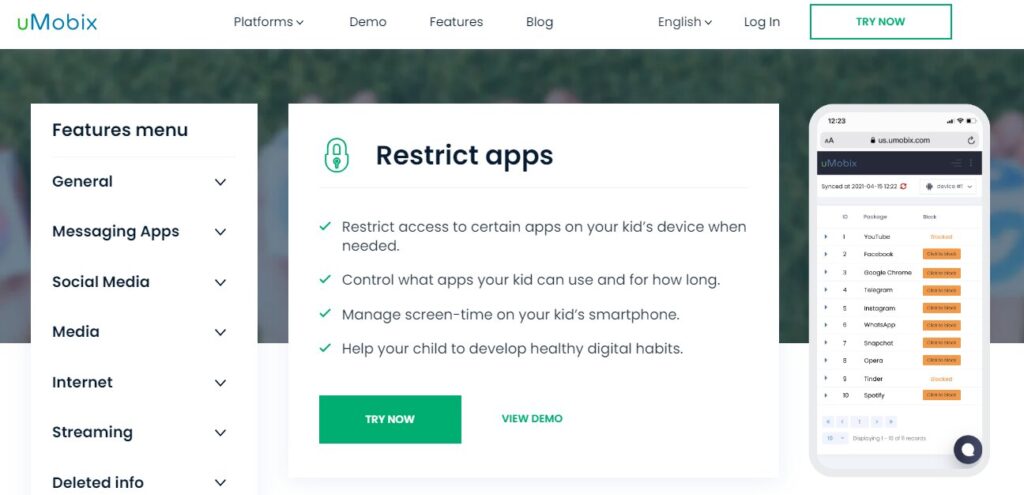
Navigating the maze of social media and gaming apps can feel like a full-time job for parents. You want your kid to enjoy the digital world, but you also worry about what they might stumble upon.
That’s where uMobix steps in. Its restrict apps feature is a game changer, letting you take charge of what your child can access. Need to block distracting social media during homework? Or maybe limit gaming late at night? No problem! With uMobix, you can help your child build healthy digital habits while keeping their tech use safe and balanced.
- Restrict access to specific apps: You can limit or restrict apps on your child’s device whenever you feel it’s necessary. This way, they only engage with content that’s suitable for their age.
- Control app usage time: Set time limits on how long your child can spend on specific apps. This encourages them to take breaks and helps reduce excessive screen time.
- User-friendly dashboard: The software is easy to navigate, making it a breeze to apply and modify restrictions whenever you need to.
- Instant activation: Any restrictions you set kick in immediately, giving you real-time control over your child’s app access.
Conclusion
The internet can be a blast for minors to connect and explore, but it also comes with some real risks that can mess with their safety and mental health. Seriously, some of those statistics are a bit scary – what looks like a chill app can turn into a magnet for unwanted attention or content.
That’s why it’s key to stay in the loop about what apps they’re on and to use tools like uMobix to help keep things safer. It’s not just about blocking stuff; it’s about having real talks with our kids about the dangers that are out there. Encourage them to hit you up with questions and share their experiences – this way, they’ll feel more confident making smart choices online.
